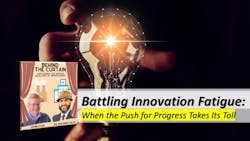Podcast: Battling Innovation Fatigue: When the Push for Progress Takes Its Toll
Imagine this scenario: Your schedule is packed with stuff to get done. Meanwhile, you’re fighting fires on the plant floor, expenses are climbing, production goals are missed, customers are upset and raging, and the workforce is burnt out.
Amid this chaos, in walks the CEO, who says, “Hey, we need to make some changes here for the better.” You simply stare at him with zero enthusiasm.
What’s happening? It’s a phenomenon the podcast hosts of Behind the Curtain: Adventures in Continuous Improvement call “innovation fatigue.” And it’s typically found in organizations that have gone through multiple iterations of improvement transformations that didn’t work or in organizations that have just completed a huge change—deploying an ERP system, for example.
In this podcast episode, co-hosts Dr. Mohamed Saleh and John Dyer discuss innovation fatigue—how to recognize it, understand it and reengage employees who have seen it all before and aren’t enthused to see it all again.
A key message Saleh and Dyer share early on is that innovation fatigue is not a type of resistance to change, although it may look like it.
“[People] are just exhausted from all this innovation. And here you come in, and you want more innovation,” Saleh says. “We need to recognize the level of fatigue individuals go through, and that they're not resistant to change. They're just exhausted from change.
“Does that mean you just back off and not do anything? Absolutely not.”
Much of the continuous improvement experts’ discussion centers on five company characteristics they say factor into innovation fatigue. They are:
No risk to innovation: They copy others, with the idea that someone else has gotten the bugs out. "If no one's done it before, they don't want to do it because they're just exhausted from the change,” Saleh says.
Innovator deficiency: “Sometimes the issue is that we tried it before and it failed, and rather than learn from it, we just kind of retract from it.”
Breaking the will to share: People's ideas have been stolen in past transformation efforts. “That kills trust and silences them moving forward,” Saleh says.
Flaws in decision-making or a lack of vision that destroy trust. As an example, the hosts outline a short-sighted decision to lay off people because of an improvement initiative that reduced labor needs in an area. Leaders could have relied on attrition or reassignment of the affected individuals rather than a layoff, but they didn’t. The result is a hostile remaining workforce.
Legal or intellectual property challenges that complicate change. Some highly regulated industries require governmental review for even simple changes. It can become a “monumental thing” that demotivates people from making changes, the hosts say.
